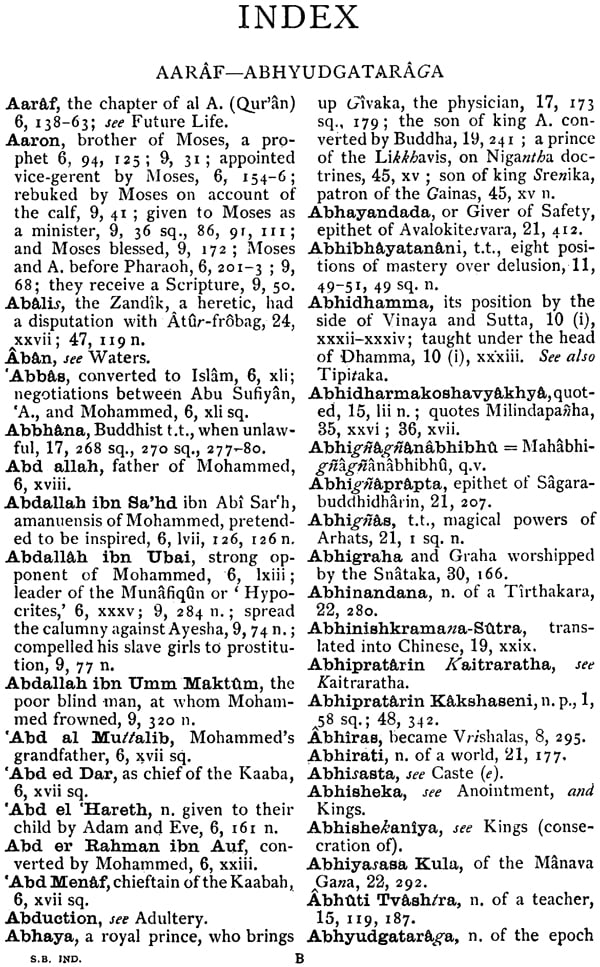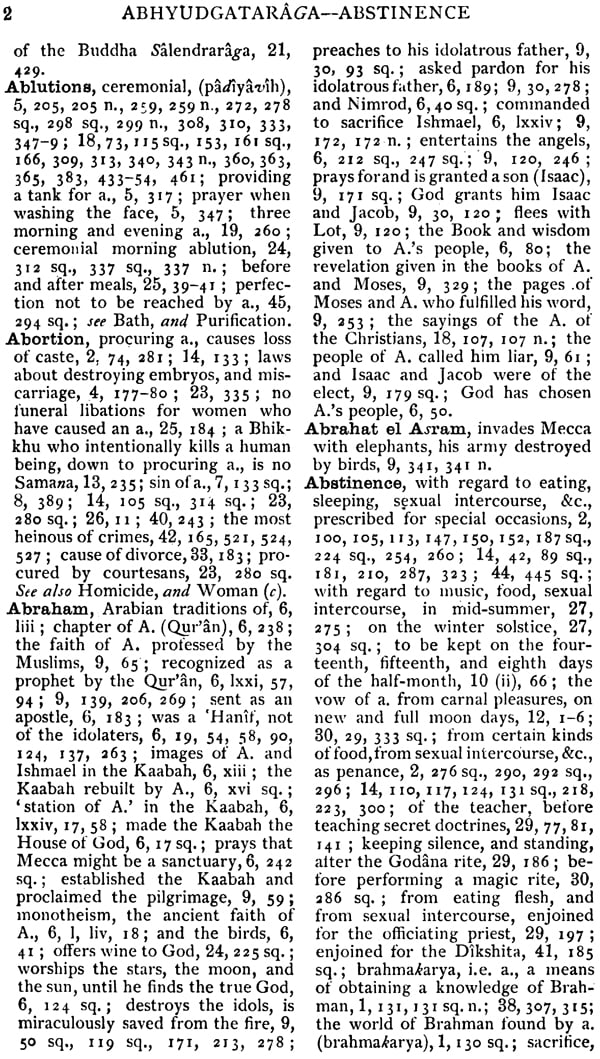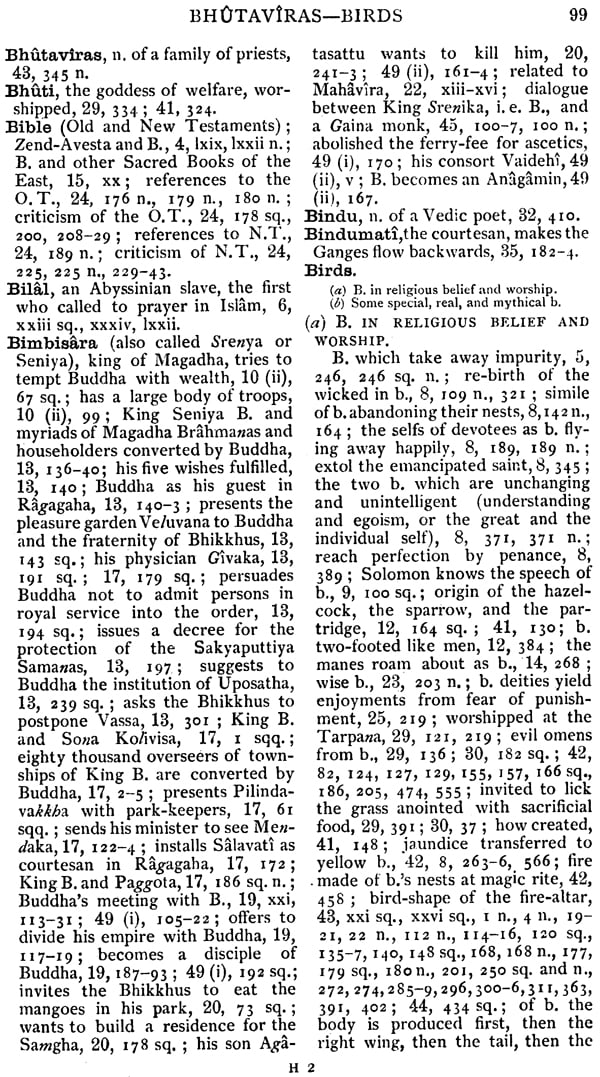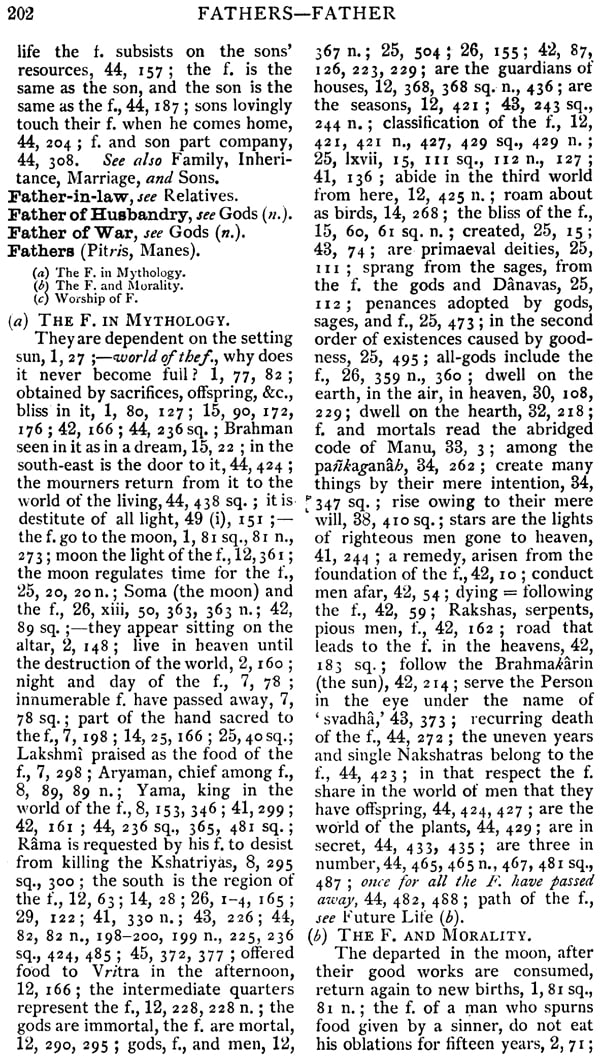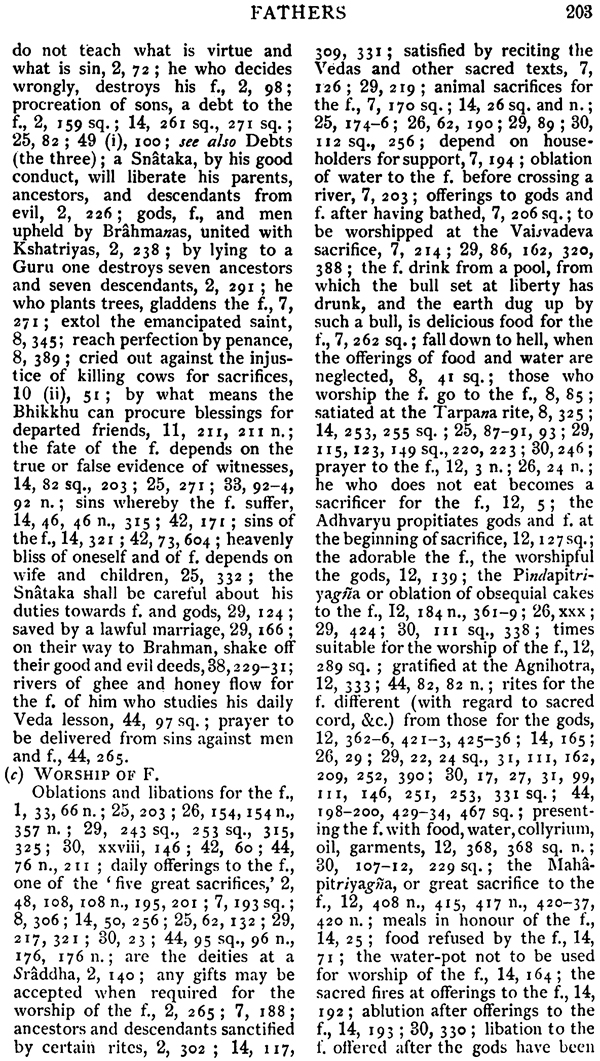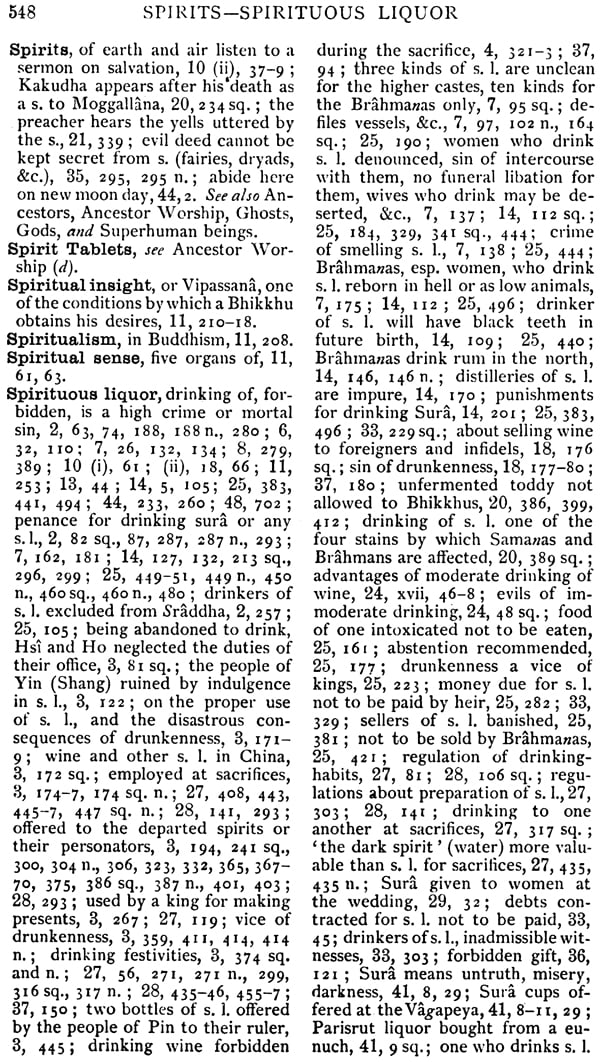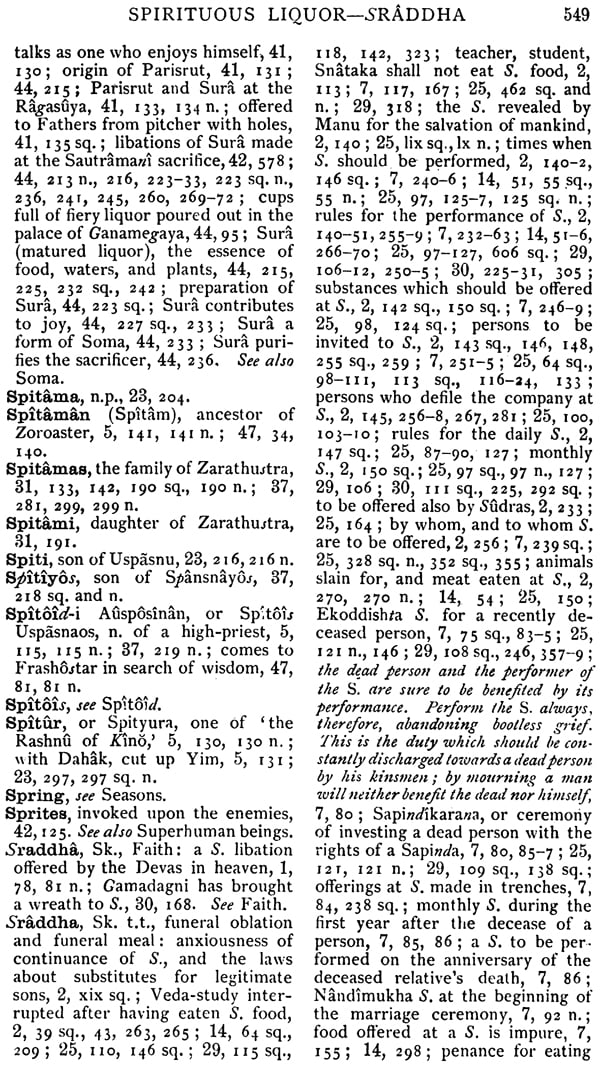
A General Index to The Names and Subject Matter of The Sacred Book of The East
Book Specification
| Item Code: | NAM244 |
| Author: | F. Max Muller |
| Publisher: | Motilal Banarsidass Publishers Pvt. Ltd. |
| Language: | English |
| Edition: | 2009 |
| ISBN: | 9788120801509 |
| Pages: | 702 |
| Cover: | Hardcover |
| Other Details | 9.0 inch X 6.0 inch |
| Weight | 1 kg |
Book Description
The period covered by the inception, the publication, and the completion of the Sacred Books of tile East exactly coincides with the thirty-four years that I have spent in Oxford. When I matriculated, Professor Max Muller, the editor of the series, was about to begin work on the first volume, which appeared while I was still an undergraduate. I lost no time in making his acquaintance, for it was the influence of one of his works that had stimulated me to begin under Professor Benfey the study of Sanskrit at the University of Gottingen, when I left school nearly two years before. During my undergraduate days and later I owed much to Professor Max Muller's advice and encouragement in regard to my studies, which have ever since followed, as far as Sanskrit is concerned, much the same lines as his. I consequently always took a lively interest in the Sacred Books edited by him as they successively appeared during the course of a quarter of a century) no fewer than thirty-six volumes having a more or less direct bearing on my own work, and fourteen of the translators being personally known to me. Professor Max Muller lived to see all but one of the forty-nine volumes published under his supervision. Now the fiftieth and concluding volume is at last finished when I myself have already arrived at advanced middle age. Owing to my early relations with the editor and my interest in the series ever since, I am glad to have this opportunity of accompanying with a few words by way of preface the volume that brings the series to an end.
The Sacred Books of the East include all the most important works of the seven non-Christian religions that have exercised a profound influence on the civilization of the continent of Asia. Of the Indian religions the Vedic-Brah-manic system here claims twenty-one volumes, Buddhism ten, and Jainism two. Eight volumes comprise translations of the sacred books of the Persians. Two volumes represent Islam, and six the two main indigenous systems of China, Confucianism and Taoism. This great undertaking, planned and edited by Professor Max Muller, has been carried out by the collaboration of twenty scholars, all leading authorities in the special departments of Oriental teaming to which the works translated by them belong. By thus rendering these religious systems accessible as a whole to the Western world in authoritative translations, Professor Max Muller for the first time placed the historical and comparative study of religions on a solid foundation. But with that large view of the aims and needs of scholarship which distinguished him, he saw that the investigation of the vast material here collected could not become thoroughly effective without the auxiliary aid of a separate index volume presenting that material thoroughly digested and exhaustively classified. This work he entrusted to Dr. Winternitz, who at that time was resident in Oxford and had been assisting him in bringing out his second edition of the Rigveda with the commentary of Sayana, The result, after various unavoidable delays, is the present volume, in which the end in view has been most successfully accomplished by the compiler, now Professor of Indian Philology and of Ethnology in the German University of Prague.
The experience of many years has made me a convinced believer in the great value of full and comprehensive indexes as aids to the scholar, not only because they save his time, but because they tend to render his results more comprehensive. This is especially true at the present time, when the field of research has become so greatly extended in all directions. The view which prevailed among Oriental scholars in my student days was very different. About thirty years ago an eminent Sanskrit scholar began the publication of the edition principle of an important and intricate work, which when completed appeared without an index. The editor declined to yield to the suggestion that he should supply one, declaring that those who wished to consult the book on any point ought to be compelled to read it through. I feel convinced that as a consequence of this attitude, research has been retarded in the branch of learning to which the work in question belongs. Even in recent years I have hardly ever seen an index to Oriental works that has not seemed to me too meagre and consequently inadequate as an instrument of research. Very different is the character of the present substantial volume of 684 pages, which Professor Winternitz has compiled with so much thoroughness and industry. I feel no hesitation in starting that it is the most comprehensive work of the kind that has yet been published. For it is not merely a complete index like vol. xxv of the recently published Imperial Gazetteer of India. It also furnishes, in articles of any length, a scientific classification of the subject under various heads. Thus, in the article on Agni, the Indian god of fire, the material relating to that deity is arranged under no fewer than twenty-four subdivisions. Such fullness of treatment saves the book from the inevitable dryness from which it would otherwise suffer. Indeed, its perusal will, I believe, prove interesting not only to the expert, but even to the general reader. The volume, in fact, constitutes a handbook for the study of Oriental religions as far as represented by the Sacred Books of the East. By saving the student of these volumes an immense amount of time, it will greatly lighten his labours. The methodical arrangement and the co-ordination of the vast and varied material that they contain are also calculated to stimulate both the historical investigation of each, and the comparative study of all, of the religious systems dealt with in the series. Hence if I were asked to select any one of the fifty volumes of the Sacred Books of the East as specially useful, I should certainly choose the last. The Delegates are to be congratulated on rounding off with so valuable an addition a series that reflects so much lustre on the University Press, and has contributed not a little towards establishing its now unrivalled position as a centre of Oriental publication.
Habent sua fata libelli-not only after they have been published, but sometimes even before they are printed. It was in the spring of 1894 that the late Professor Max Muller first suggested to me that I should compile a General Index of the names and subject-matter for the complete series of the Sacred Books of the East. Such an Index, he thought, would be a great help to all students of the Sacred Books of the East, and of the greatest value for the study of the history of religions. The matter was frequently discussed between us, and we both agreed that if the Index was to be of any use it would have to be, not a bare list of names and important words, with strings of references which no one would have the patience to read through, but an analytical Index with extracts and even verbai quotations, from which the student, with the least possible trouble, might see to which volume and page he had to refer for any information he might want. It was many weeks before the plan took any definite shape; in June; 1894, I laid my proposal of preparing the Index before the Delegates of the University Press, who were from the beginning favourably inclined to it. But as I had to work out a specimen from which the scale and the plan of the Index could be seen more definitely, it was not until March, 1895, that the Delegates could give their final sanction to the work.
Though some of the volumes of the series were still unpublished in 1895-vol. xliv appeared in 1900, and vol. xlviii not until 1904-it was then thought possible to finish the Index volume within two years. When I set to work, and began reading through volume after volume, making notes and extracts for the Index, I certainly hoped that Professor Max Muller would live to see it finished. But, alas, Fate had destined otherwise. Only too soon I found that I had entirely miscalculated the time and labour involved in the compilation of the Index. By the spring of 1898 I had indeed read, and made extracts from, all the volumes that had been published; I had written some 70,000 slips, and these had been sorted and arranged alphabetically. But in 1898 I left Oxford to return to my own country and to a new sphere of work, and the preparation of the Index had to be interrupted for nearly two years. When I took it up again in 1900 I soon found that the huge mass of slips before me represented only the raw material from which the building had to be constructed.
From the beginning it had been clear to me-and this was also Professor Max Muller's view-that this Index volume could not be made like any other Index, but must resemble a Manual of the History of Eastern Religions. For it would have been of little use to collect, under such headings as Ancestor Worship, Animals, Brahman, Buddha, Fire, Funeral Rites, Future Life, God, Gods, Prayer, Sacrifice, Soul, &c., all the passages bearing on these subjects as they occur in the volumes of the Sacred Books of the East. It was necessary to make sub-divisions in such articles, and to arrange the passages under different sub-headings. It was this work of arranging and condensing the raw material that caused so much delay. Many slips had to be rewritten, and the volumes of the Sacred Books had constantly to be referred to, and numerous passages to be verified.
These sub-divisions and sub-headings required most careful consideration. It was not possible to make them according to one uniform scheme; they had to be chosen in each case differently as seemed most suitable for practical purposes. Sometimes it was advisable to make them according to the different religions, sometimes according to the subject-matter. Consistency could not be aimed at-the chief aim was practical usefulness. Sometimes it seemed more practical to arrange the passages under several sub-headings, sometimes it seemed preferable to collect them under one heading, indicating subdivision by dashes (-). But it is hardly necessary to enumerate all the devices by which the compiler has tried to make the Index as handy as possible. The reader will easily find them out for himself. There was a time when German scholars scouted the idea of writing or using an Index to learned books. It was thought unworthy of a scholar to look to an Index for reference: he had to read the whole book and all the books on any given subject. But nowadays even German scholars have found out that life is short, and not only art, but in an even greater degree, science is getting very long. It has become impossible to get on without some time-saving machinery. To make this Index supply as far as possible a contrivance of such a kind has been the one and constant aim of the compiler.
Verbal quotations have been given-they are marked as such by the use of italics-from passages that seemed especially characteristic and important. That the Index should also include such verbal quotations, was one of the very first suggestions made by Professor Max Muller.
The compiler of an Index to forty-nine volumes of translations from seven different languages, belonging to as many religions, had to grapple with peculiar difficulties. He had not only to make himself acquainted with the terminologies of the different religions represented in the Sacred Books of the East, but also to take into account the different translations of the same terms by different translators, sometimes also different spellings of the same names in different volumes. I have tried, as far as was practicable, to collect all things belonging together under one heading, but I must apologize for any inconsistencies that will be found, especially under the letter A. There, e. g. "Ahura-Mazda ' and' Auharmazd' are given as two separate articles, while later on in such cases all the passages would have been collected under one heading. While apologizing for such and other inconsistencies (which could only have been avoided if the whole manuscript of the Index had been rewritten and its publication delayed still longer), I hope to have given so many cross-references that these inconsistencies will not be felt as any serious inconvenience.
When I venture to claim for this volume the title of a sort of Manual of the History of Eastern Religions, I hope I may not be misunderstood. Many books on the History and Science of Religion have been written during the last twenty years. But most of these books are more concerned with theories on the origin and development of religion than with what, in my humble opinion, should be the foundation of all such theories-a scientific classification of religious phenomena. Is it too presumptuous to hope that this Index may prove to be of some help for the fulfilment of this desideratum of the Science of Religion? The Index may prove useful, not only for what it contains, but also for what it does not contain. The student of religion will look in vain in this Index for such terms as Animism, Fetishism, Tabu, Totemism, and the like. May not this be a useful warning that these terms refer only to the theories and not to the facts of religion? On the other hand, the student will be assured that everything he finds in this Index is a religious fact. Moreover, many things will be found in the Index that, from our point of view, do not refer to religion at all, but to all kinds of matters of importance for the Antiquarian-the student of ancient law, customs, manners, art, and economic life. For there is hardly any phase of human life that is not in some way or other touched upon in the Sacred Books of the East-for the simple reason that in ancient religion almost anything and everything has some religious aspect. This is in itself an important lesson to learn. Besides, it, shows how useful the Index, and of course still more the Sacred Books themselves, must be for all students of the ancient civilizations of India, Persia, China, and Arabia. And if the Index should do nothing else but help to promote the study of the Sacred Books of the East, the time and labour devoted to its compilation will not be thrown away.
In conclusion, I have to express my sincere thanks to the Delegates of the University Press for the sacrifices incurred in the publication of this volume, and for the patience they have shown with the many delays that have retarded the completion of the work.
| Preface | vii |
| Introductory Note | xi |
| List of Religions Represented in The S. B. E. | xv |
| List of The Translators | xv |
| Key to Abbreviations | xvi |
| List of The Volumes of The S. B. E. | xvi |
| The Index. | 1-683 |
| Addenda and Corrigenda; Note on The Editions Vols. 2, 4, 10 . | 684 |
